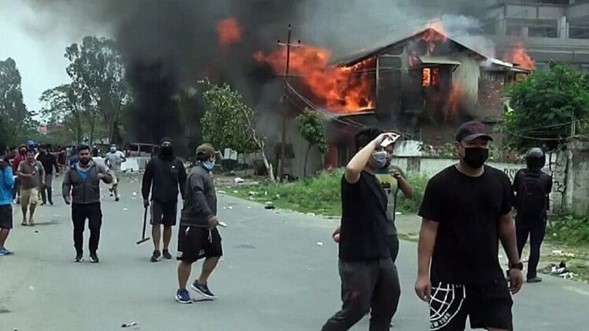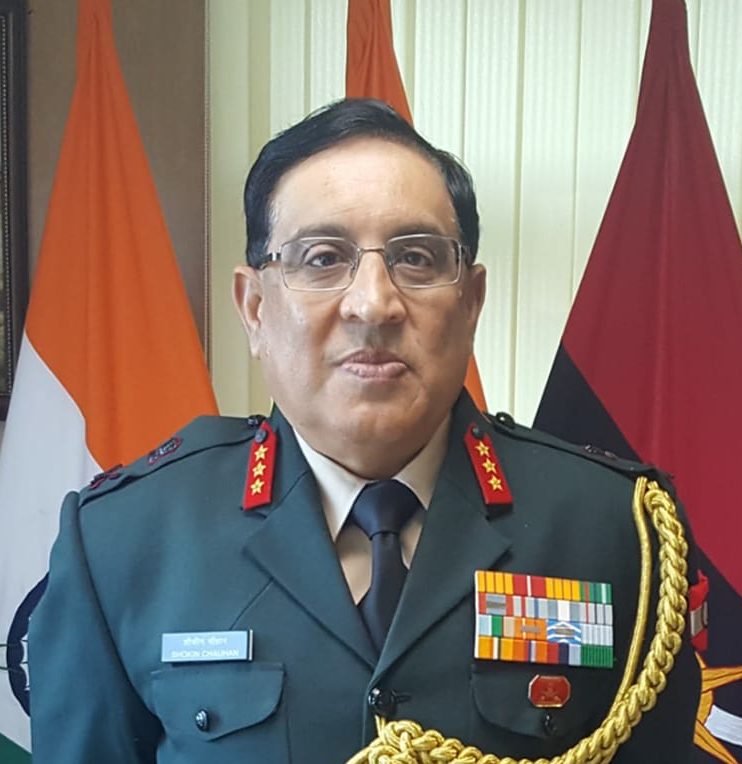
The Crisis In Manipur : An Assessment

“The situation in Manipur has not yet been resolved, the violence not yet abated and the actual truth not yet clear. Much of the narrative you hear about the violence in the state depends upon who tells it to you and his or her ethnicity.”
Manipur is a state in northeast India, geographically, bounded by the states of Nagaland to the north, Mizoram to the south and Assam to the west. It also borders two very volatile regions of Myanmar, the Sagaing Region inhabited mainly by the Bamar (Burmans), who live in the dry zone regions and along the Ayeyarwady River to the east and the Chin state to the south. The term ‘Chin’ initially as used by the Burmese in Myanmar referred to all the hill tribes in the western frontier of Myanmar. However, in India the hill tribes are divided into two groups namely the Chin-Kuki and the Naga.
The official and most widely spoken language is Meitei language and is native to the Meitei people, it is also used as a lingua franca by smaller communities, who speak a variety of other Sino-Tibetan languages. Manipur has been at the crossroads of Asian economic and cultural exchange for more than 2,500 years. It connects the Indian subcontinent and Central Asia to Southeast Asia, East Asia, enabling migration of people, cultures and religions.
During the days of the British Indian Empire, the Kingdom of Manipur was one of the princely states. Between 1917 and 1939, some people of Manipur pressed the princely rulers for democracy. By the late 1930s, the princely state of Manipur negotiated with the British administration its preference to continue to be part of the Indian Empire, rather than part of Burma, which was being separated from India. On August 11, 1947, Maharaja Budhachandra signed an Instrument of Accession, joining India. Later, on September 21, 1949, he signed a Merger Agreement, merging the kingdom into India, which led to its becoming a Part C State. This merger was later disputed by groups in Manipur, as having been completed without consensus and under duress. The dispute and differing visions for the future has resulted in a 50-year old insurgency in the state for independence from India, as well as in repeated episodes of violence among ethnic groups in the state.
Three distinct communities constitute the State of Manipur. Two of them are the Naga and Kuki tribes while the other is the non-tribal Meitei. Whenever demands are made by the Meitei, who is the dominant community representing more than half of the population of Manipur, the tribes have not stood on the way as they are just about 41% of the State’s population and have no real political power. The Manipuri language is in the Eighth Schedule of the Constitution which has allowed the dominant community much benefits as Manipuri language, is allowed to be used in the Civil Services Examinations and also in the Central Armed Police Forces (CAPF)Examinations.
The Meitei people represent around 53% of the population of Manipur state, followed by various Naga ethnic groups at 24% and various Kuki/Zomi tribes (also known as Chin-Kuki-Mizo people) at 16%. Manipur’s ethnic groups practice a variety of religions. According to 2011 census, Hinduism and Christianity are the major religions of the state.
The ST Conundrum
A section of the Meitei community has been demanding inclusion in India’s Scheduled Tribe Lists especially since it would give them special land rights and protection, economic packages, job opportunities and other facilities. As they persisted in their demand of ST status, the “Ministry of Tribal Affairs, Government of India wrote a letter on May 29, 2013, addressed to the Government of Manipur asking it to submit “a specific recommendation along with the latest socio-economic survey and ethnographic report.”
Since Manipur Government did not respond, a writ petition was filed in the High Court of Manipur. The High Court of Manipur vide its order dated March 27, 2023, directed the Government of Manipur to submit its recommendation to the Ministry of Tribal Affairs regarding Meitei’s demand for inclusion in the Schedule Tribes List.
The All-Tribal Students’ Union, Manipur (ATSUM), an organisation of Kuki ethnicity, disagreed with the High Court order and decided on a protest march, and called upon several tribal organisations to participate. On May 3, 2023, a “Tribal Solidarity March” under the theme “Come now let us reason together,” was organised by ATSUM in all hill districts of Manipur. It was endorsed by Indigenous Tribal Leaders’ Forum (ITLF), Joint Co-Ordination Committee on Tribal Rights Manipur (JCCOTR-M), and others. ATSUM’s march infuriated those Meitei who demanded ST status considering it to be the only solution to economic progress, prevent transfer of land to immigrants / outsiders, and defend Manipur’s integrity. Therefore, Meitei pro-ST activists organised a “counter-protest” in the adjoining border areas of Churachandpur and Bishnupur districts.
ATSUM’s protest march was effective in Kuki dominated districts of Manipur, particularly in Churchandpur town, however Churachandpur on May 3 had not yet lifted the prohibition order under Section 2 of Section 144 of CrPC that was enforced on April 27 by the district administration. The question is how did the district administration allow the march to happen without lifting the prohibition order? Why were the organisers brandishing weapons at a march which was meant to be a peaceful one? Why didn’t the Govt of Manipur take effective pre-emptive security measures against potential violence? What were the district administrators doing? Was there intelligence failure or deliberate support to violence?
Events Post 03 May 2023
The events that unfolded in Manipur post May 03 and the subsequent weeks have been more than worrying. Several Kuki-Zomi as well as Meitei villages were burnt down and there were reports of several alleged encounters between Manipuri State Police commandos and Kuki-Zomi insurgent groups. The CM claimed that 40 insurgents were killed and several others were captured in operations and encounters across the foothills of the Imphal Valley, where the Kuki-Zomi and Meitei groups converge. The army did not confirm these encounters with the CDS insisting that this violence was not caused by the ongoing insurgency and that it was a law and order situation that could only be resolved politically.
Insurgent groups that come under the Suspension of Operations (SoO) pact with the government of India and the state government have denied they were involved in the violence, neither in any attack on civilians nor in shootouts with the Manipur police forces. They, however, hinted that “village volunteers” who defended their villages and land from aggression or attacks “have been affected” and could be involved.
This ongoing violence sets a dangerous precedent, pushing back peace talks and negotiations for a settlement by decades. The Kuki National Organisations (KNO), an umbrella body of many of the Kuki insurgent groups in this area, have made it clear they want to continue peace talks with the Centre, the nature and complexion of these talks may change. The involvement of these insurgent groups in any form of violence, which the Biren Singh-led Manipur government has been claiming, will definitely affect these groups at the negotiating table.
The SoO agreement protects the insurgent groups from action by Indian or state security forces in exchange for a halt to the insurgency. In March, 2023, the Biren Singh government unilaterally withdrew from the agreement, a move that was not accepted by the Centre and the armed forces which are also a signatory to this agreement.
The Meitei political establishment lay the blame of this violence entirely on certain segments of the Kuki community and their backing the illegal poppy cultivation as well as providing shelter and protection to illegal Myanmarese Kuki refugees who have entered the Churachandpur district with an aim of establishing a greater Kuki homeland within the state of Manipur.
The Kuki leaders on the other hand, point out that the Manipur government’s continuing persistent attacks on the Kuki-Zomi people aimed at the unlocking of protected tribal land as the real reason for the recent conflict. In a recent interview, Mr Ram Madhav a BJP leader has stated similarly, emphasising that the clash was “all about land,”. “10 per cent of the Manipur is a valley and 90 per cent of which is hills and this 10 per cent of this valley is home to 60 per cent of the people…that is where the whole clash happened,”. The BJP leader claimed that the people from the hills try to come down and take possession of the land as the valley is open whereas the hills are controlled by certain hill laws and this has been a constant reason of concern between hills and valley people.
A two-fold exodus has already occurred, the Meiteis have been driven out by the Kuki-Zomi community on the edges of the Imphal Valley and Kuki-Zomis by the Meiteis in Imphal. Meiteis living in villages adjacent to Kuki-Zomi land have fled to the Imphal Valley and the exodus was completed with the Kuki-Zomi tribes, leaving the Valley to head for the Kuki-dominated Churachandpur district.
Despite the devastation in Manipur this month, these are the early stages of a situation that could worsen unless the Centre takes quick, decisive and effective action, and the law-and-order situation is re-established. If the insurgent groups engage with state or central forces, it would only work to the detriment of the tribals’ cause. The tribal groups need to be cautious not to get drawn into any stand-off and desist from retaliating in any way.
Steps to Control the Violence
To control the situation, the army immediately moved several forces, almost 200 plus columns from neighbouring Arunachal, where they were deployed along the Indo-China LAC and the Manipur government immediately imposed curfew under CrPC section 144 in several districts and suspended mobile phone data services for five days in the late afternoon. However, video clips, photos, and messages / information / rumours of killing, injuring, raping, plundering, taking hostage, burning or destroying villages had already gone viral on social media.
It added to the already pent-up communal resentment against one of the communities that have been growing for a few years. Manipur government suspended internet broad band services and authorised the civil authority to shoot at those who defy the law.
Post the visit of the Home Minister Shri Amit Shah, the violence has reduced considerably. The HM visited the affected areas, spoke with the affected community leaders as well as the Security Forces. The responsibility of the overall command to restore normalcy was transferred from the DGP to a non-local retired IPS officer by appointing the latter as Advisor (Security). It also opened helplines and relief centres for victims. Government of India deployed additional military and paramilitary forces. In all these hundreds of Meitei and Kuki people have lost lives or suffered casualties. A judicial inquiry has been ordered and several measures have been taken to reduce the violence.
Can the three communities continue to live together?
By concentrating all major institutes at the Union and state level in and around Imphal, the political administration has created pressure on land not only for the establishment of various institutions but for roads, utilities and residential houses for the increasing population in the urban centres. As a result of this short-sightedness, the pressure on land in this area has increased exponentially. This pressure likely has fuelled the debate amongst a section of the Meiteis about the question of land ownership in the state’s hill areas. Everything of importance is located in the valley, namely the Raj Bhavan, the assembly, the secretariat, the high court, the airport, national-level sports infrastructure, universities, a Union-level medical hospital and college, a state-level medical hospital and college, central institutes of learning, central offices, etc.
Further it is recommended that the political leadership must share power by including elected representatives from the hill areas. Manipur must allow the district councils in the hill areas to govern themselves under Article 244 and the sixth schedule of the constitution. They should enable the Hill Areas Committee (HAC) in the legislative assembly to function effectively for assisting the state and district administrations, and allow them to frame laws on various matters for the hill areas. Further, they must build new state and Union-level institutions as well as sports infrastructure in the hill districts, so that give equal opportunities are afforded for all the people of Manipur.
Disclaimer
The opinions expressed in this article are the author’s own and do not reflect the views of Chanakya Forum. All information provided in this article including timeliness, completeness, accuracy, suitability or validity of information referenced therein, is the sole responsibility of the author. www.chanakyaforum.com does not assume any responsibility for the same.
Chanakya Forum is now on . Click here to join our channel (@ChanakyaForum) and stay updated with the latest headlines and articles.
Important
We work round the clock to bring you the finest articles and updates from around the world. There is a team that works tirelessly to ensure that you have a seamless reading experience. But all this costs money. Please support us so that we keep doing what we do best. Happy Reading
Support Us















POST COMMENTS (4)
Brig Amul Asthana (Retired)
Rudolph Coutinho
Ajay Sachdev
Prof. Shailendra Naresh Kulkarni